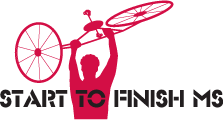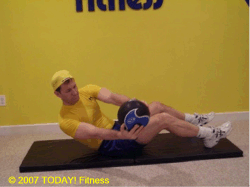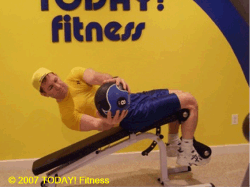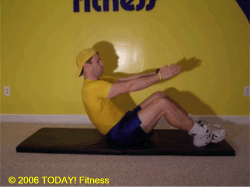|
Cycling 101 |
|
I guess I’m a little partial
to cycling since I was never really a runner. Even before I
tore the cartilage in my knee back in high school I was
pretty slow. I had some body quickness on the wrestling mat
and off the line in football, but when it came to
acceleration and speed after the first couple steps.. forget
it!
I mention this because not
everyone is a runner, nor does everyone have to get on the
treadmill or pound the pavement for countless miles to get a
good cardiovascular (aerobic) workout. I got into
cycling initially when I was overweight and looking for a
way to start getting a cardio workout. With my knee being a
problem, cycling provided a nice, controlled, low impact
motion while still getting my heart rate up.
As I got
more into fitness and exercise, I purchased my first heart
rate monitor to focus on the intensity of my aerobic
workouts.
I
was initially amazed by how quickly I was able to get my
heart rate up while cycling. For me it was much easier to
get to the top of my
training zone when cycling outdoors,
then any of the indoor workouts that I had done in the past!
The perceived exertion when
cycling outdoors is much less then on a stationary bike,
even though you are still getting an excellent workout.
Between the constantly changing scenery and the need to get
back to the starting point, I have more
motivation to start and finish every cycling workout.
So how do you get started?
Well, it’s just like riding a bike (sorry, couldn’t resist).
Seriously though, when you first get into cycling, you’re
going to want to see what you’re capable of. If you plan to
ride for 30 minutes, then set out in any direction for 15
minutes and then turnaround and come back.
When riding on the road, it’s
not necessary to have a road bike that costs thousands of dollars, but it does help when you are looking for
speed. If speed is not as important to you, then you can
pretty much use any bike on the road. One thing I would
recommend though is to switch from the knobby tires to some
smoother road tires if you decide to use a mountain bike.
Between the resistance on the road and the constant hum of
the knobbys you’ll get frustrated real quick!
For fitness cycling, it’s good
to try to keep your legs pumping at a constant cadence (the
rate of pedal revolutions) for the entire ride.
You can shift gears when necessary to keep a cadence that
you are comfortable with (typically 60-90 rpm), and you will want to pace yourself
in the beginning until you better understand your level of
aerobic fitness as well as the muscle endurance in your
legs.
|
|
Cycling
Essentials |
|
For those
new to biking... I thought I'd run through the essentials
that you will want to have while riding.
-
Helmet - you might
feel (and look) a little goofy wearing it, but I know
people that have cracked them in half in an accident...
better than the alternative!
-
Bike Shorts - I swore
that I'd never wear these when I first started cycling,
but after my first Bike to the Bay, and 150 miles sitting
on a little piece of plastic/leather and foam, I bought my
first pair the next day! The more expensive, the
better the padding in the seat usually... well worth the
extra $.
-
Water Bottle -
HYDRATION, HYDRATION, HYDRATION... 'nuff said.
-
Tire Changing Stuff -
spare tube or patch kit, plastic tire Irons, tire pump...
these are all your friends if you get a piece of glass or
other sharp debris in your tire. Knowing how to use
them is equally important... the tires don't change
themselves you know.
-
Seat
Pack - this little pack that sits under your seat is
great for storing your tire changing stuff and maybe a
cell phone for emergencies.
-
Sun Glasses - In
addition to keeping the sun out of your eyes, these also
help to keep the occasional gnat or other flying pest out.
-
Bike
Computer - Beneficial for training purposes as well as
during the ride, most bike computers tell you your current
speed, average speed, duration, distance, and an
assortment of other valuable information about your ride.
More cost typically means more features which can include
cadence, heart rate, and more.
-
Shirt - Sure you can
throw on a cotton t-shirt, but if you sweat like me your
not going to be very comfortable on the hot days.
Most cycling jerseys are made with material that wicks
away the sweat so that it dries faster and cools you off.
I personally like the under armor heat gear as well if not
better.. I never use those pockets in the back of the
cycling jersey's anyway.
-
Pedals - Standard
pedals good... toe clips better... clip-less pedals with
bike shoes best. Pedal clips stabilize your foot on
the pedal to help prevent slippage as well as allow you to
pull up on the pedals for additional force production and
exercise.
-
Gloves - Optional,
but useful for gripping the handlebars, reducing road
vibration through your hands, and wiping sweat from your
face.
-
Oh
yeah... I almost forgot... you need a bike too!
For the road... mountain bike good (with road tires),
hybrid better, road bike best. My first couple were
mountain bikes, but when I started to spend most of my
time on the road, I upgraded to a hybrid. Hybrids
have gearing between a mountain bike and a road bike and
the handlebars of a mountain bike. Road bikes have a
more aggressive seating position for better aerodynamics
and speed and are typically much higher in price
than the other ones. Regardless of the type
you choose, the more expensive the bike,
the better components and lighter frame you typically get.
|
|
Bike to
the Bay |
|

For the past 11
years I have participated in the National MS Society's annual
MS150 Bike Tour to help raise funds for research and local
programs. It's a small thing for me to do for people who face
the devastating and relentless effects of MS every day. With
each mile I ride, I hope to bring the National MS Society
closer to a cure. The 2007 ride is scheduled for
Saturday, September 29 and Sunday, September 30th.
Multiple
sclerosis affects lives every moment of every year. At any
time, someone with MS may suddenly be unable to stand up, hug
their child or see a friend across the room.
This is my second year as a co-captain of the Bank of America
team.
If you are interested in participating in the Delaware MS150
Bike to the Bay this year, you can email me at
pmazzeo@todayfitness.net
or
click here to join Team Bank of America.
Sponsor dollars
are good too! If you are able make a
charitable donation
by sponsoring me for the ride, we can reach our goals that
much quicker! Every dollar contributed will help us to end the devastating effects
of MS, sooner rather than later.
Thanks for your support!
|
|
|
Elite
Bodyweight Exercise of the Month! |
|
Russian Twist

Summary:
People are always searching for great abdominal exercises.
There are probably hundreds of exercise variations out there
and plenty of combinations that you can put together to get a
great abdominal workout. There are a bunch of variations
of the russian twist, but the concept remains the same.
The twisting motion is excellent for strengthening the upper
and lower abs as well as the obliques. By adding the
additional weight of a medicine ball you can up the resistance
for even more of a challenge. (Click
here for information on how to make home-made
medicine balls)
Target:
stomach and sides (rectus abdominis, obliques)
Count:
2 count
Description:
From a seated position, hold a medicine ball straight out in
front of you. Keeping your arms straight with your
elbows locked, twist the ball as far as you can to one side,
pause, and twist back to the other side. The further you
lean back, the more difficult the exercise becomes.
Beginners can start without the use of the ball while more
advanced people can try performing the exercise on a declined
bench or slant board for more resistance.


|
|
What Sup? |
|
Dietary supplements are
useful primarily to athletes who have a specific
nutritional deficiency or who do not take in adequate
vitamins and minerals in their normal diet. Many
advertised supplements do not serve any useful purpose.
There are no established nutritional deficiencies
associated with sport training that would necessitate
supplementation over normal ingestion of food and
drink. Doses of dietary supplements exceeding minimum
requirements have not generally been demonstrated to
produce
ergogenic effects.
The claims of the
manufacturers of dietary supplements are usually so
flimsy that they can be dismissed as having no credible
basis without the need for conducting expensive
experiments. It is more typically the case that
products have simply not been tested for
safety, despite the claims on the container or in
accompanying literature. The expensive and elaborate
tests necessary to screen all these substances are not
practical. Safety tests are usually performed only
after a question of health risk arises.
Athletes can protect
themselves against fraud by carefully reading the labels
and claims associated with a product. Products
described by vague scientific-sounding
jargon, such as “detoxify” and “energize,” probably have
no known benefits.
Consumers can help protect
themselves against quality control problems by favoring
products made according to established manufacturing
standards (eg., labled U.S.P.) and from nationally known
food an drug manufacturers. “Natural” has no meaning in
terms of safety, as many natural products are also
poisons!
The 1994 DSHEA legislation
on dietary supplements created a new Office of Dietary
Supplements at the National Institutes of Health to
correct some of the deficiencies in research and to
provide reliable information to the U.S. public on
dietary supplements. Current information can be
obtained through their website at
http://dietary-supplements.info.nih.gov .
(Ref: NSCA Essentials of
Strength and Conditioning)
Supplementation is often a
controversial issue that is debated between the
bodybuilding community and various medical and research
organizations. The fact is supplementation is
essential in every day life. Let me clarify this
statement... I'm not saying that everyone needs to go
out and spend hundreds of dollars on powders and pills,
but it is wise to supplement your diet, especially when
you are exercising.
Water is probably the most important and
overlooked supplement!
In addition to your standard daily intake, you need to
increase your water consumption when exercising.
Besides preventing dehydration, water helps the muscle
cells to volumize and function better. This has a
direct impact on athletic performance.
Another commonly
recommended supplement for both health and athletic
performance is a multi-vitamin.
It seems so basic and simple, but it's very important!
If you are deficient in even one vitamin or mineral,
your gains can really be hampered. A good multi-vitamin
is a must for the best gains in muscle mass, not to
mention good health. People who are working out
need more vitamins than the average couch potato.
Although both water and multi-vitamins are two basic
supplements that are beneficial whether you are
exercising or not, there are also a great deal of
supplements that should not be taken by the average
person. There are still more that you should
research first to understand the potential side affects,
and proper usage before trying.
Supplements are named accordingly... they are meant to
fill the nutrition gaps that you may have created in
your diet. Medical experts state that most of the
benefits that you seek to obtain from supplements should
be attainable through eating a well balanced diet.
However, there is an increased need for supplementation
among athletes and fitness enthusiasts when frequency
and intensity of exercise is elevated and it is not
practical to consume the necessary type and quantity of
food to provide the required nutrients.
|
|
It's
Go Time! |
|
So who's
not working out... yet? I don't want to hear that you
"don't have time" or "can't get to the gym". Did you
just finish reading this eNewletter? I just read it
again myself and it took me between 5 and 10 minutes to get
through it. As I have mentioned before, it doesn't
take much to get a total body workout. You can do 50
body weight squats, 20
bicycle crunches, and a
maximum set of
pushups in just a few
minutes. This mini circuit takes hardly any time to
do, uses no equipment, and works your lower body,
midsection, and upper body. Next excuse?
You don't
have to wait until you can spend an hour at the gym 5 days a
week before you "start" working out. Just do
SOMETHING! Put the kid in a stroller and do a brisk
walk around the block or walk up and down your stairs for a
few minutes. As short as it is, if you do the
mini-circuit above a few time a week, then try to work your
way up to 2 or 3 circuits per session, you are going to see
progress. Just try to challenge yourself any time the
workout gets too easy or switch it up a little if you get
bored. There are literally thousands of exercises out
there that you can choose from, many of them that you can do
right there in front of the TV. That's right, put down
the bowl of ice cream and step away from the bag of chips!
What's more important anyway?
For prior issues of this
newsletter go to
www.todayfitness.net/news.
Good Luck!
Pete
Mazzeo, CPT
pmazzeo@todayfitness.net
"Doubt, of whatever kind, can be ended by action
alone." - Thomas Carlyle | |